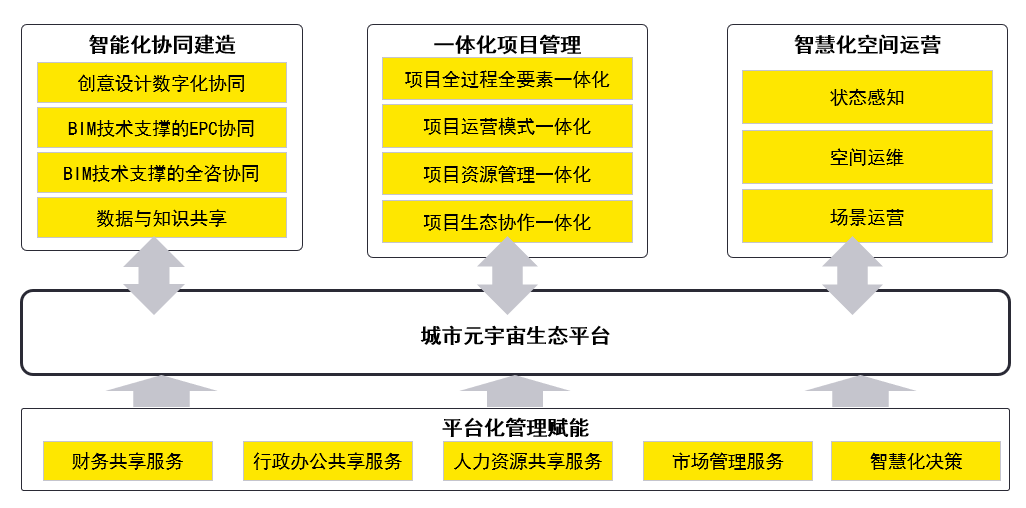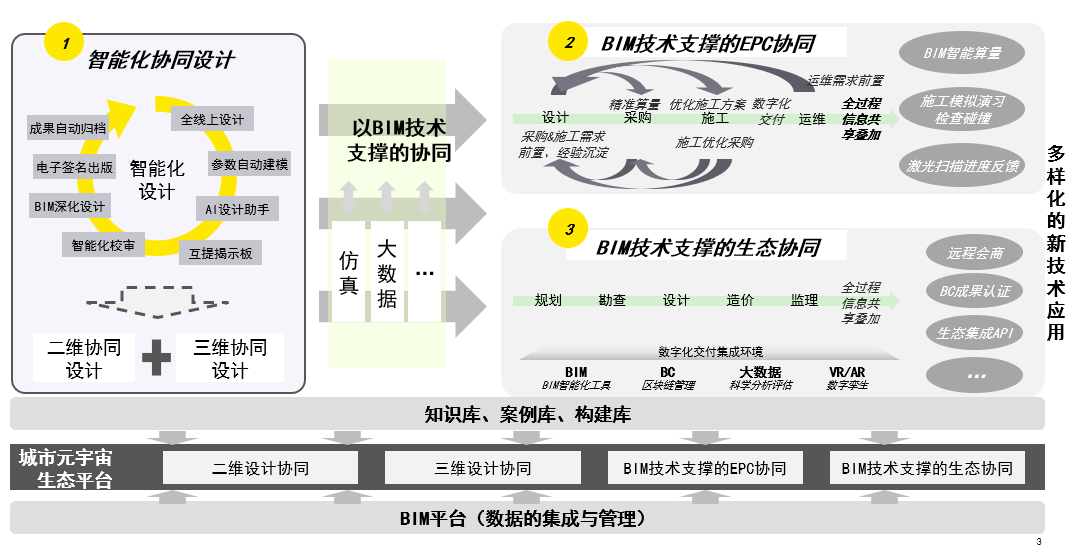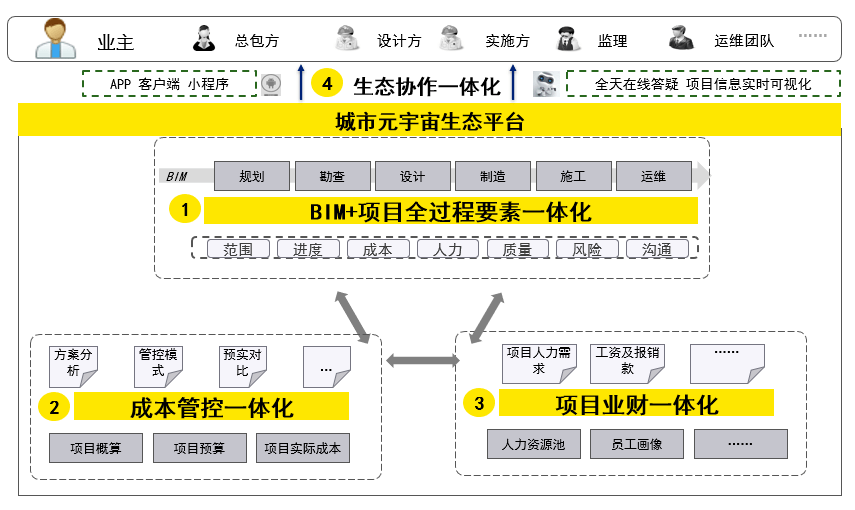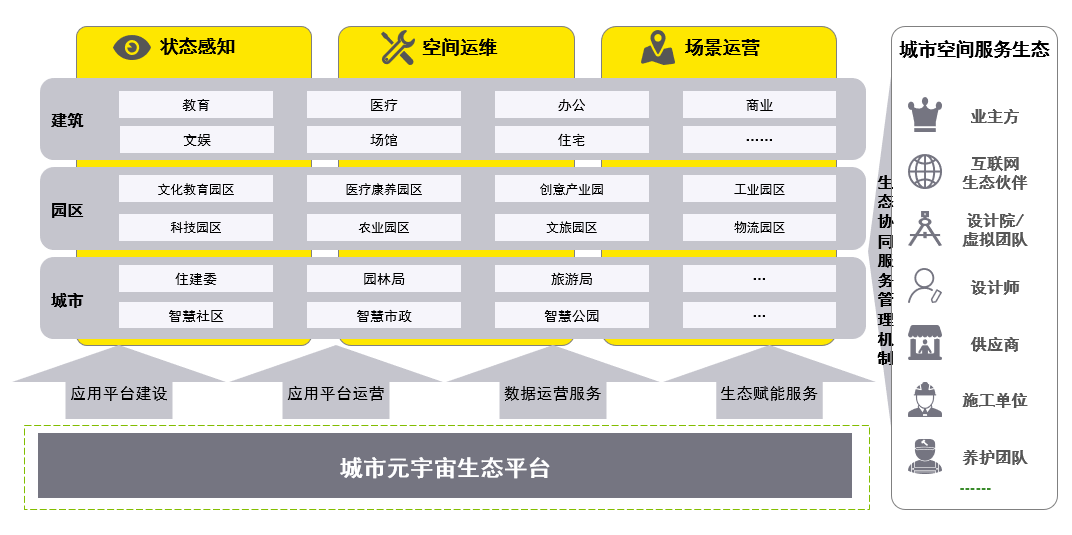

In the context of "Digital China", smart cities have played an important role in China's previous urbanization process. With the gradual improvement of new urbanization requirements, the limitations of smart city construction relying on traditional informatization and digital technologies It is also increasingly highlighted that the urban metaverse born at this time, as a comprehensive technological innovation, will inherit the achievements of past construction and lead the development of smart cities in the new era with its innate advantages in integration, interaction, and experience. This article focuses on exploring: In the context of the increasingly mature technologies related to the urban metaverse, what changes will occur in urban construction and operation, how industry participants should respond, and what breakthroughs will be created to seize the opportunity.
In July 2022, the "14th Five-Year Plan" New Urbanization Implementation Plan issued by the National Development and Reform Commission pointed out that the quality of my country's urbanization needs to be improved. The plan focuses on promoting the high-quality development of urbanization to meet the needs of the people. For the purpose of meeting the growing needs for a better life, guidance is given from five aspects: accelerating the urbanization of the agricultural transfer population, optimizing the spatial layout and form of urbanization, promoting the construction of new cities, improving the level of urban governance, and promoting the integrated development of urban and rural areas. This plan and the proposal of a series of new urbanizations since 2014 mark the transformation of my country's understanding of urbanization from focusing on quantity to focusing on quality, and from land urbanization to people-centered urbanization. At the same time, it also puts forward new requirements for urban digitalization and intelligent transformation.
1) Urbanization upgrade Smart cities are facing new challenges and are in urgent need of new solutions provided by Urban Metaverse
Since the "Thirteenth Five-Year Plan", new urbanization has made significant progress, the level and quality of urbanization have been greatly improved, the urbanization of the agricultural transfer population has achieved remarkable results, the spatial pattern of urbanization has continued to be optimized, the city's sustainable development capabilities have continued to increase, and urban and rural integration have The development institutional mechanisms and policy systems have been basically established. At the same time, the level of digitalization in cities across the country has also been significantly improved. Digital scenarios at the regional, city, park, and building levels have been continuously implemented. The digital and intelligent upgrading of social governance has achieved remarkable results. The demand for digitalization, visualization, and online urban governance is in the smart The urban construction process has been well supported.
However, with the rapid advancement of urbanization, shortcomings such as incomplete public service coverage, insufficient coordination of urban development, weak urban development resilience and anti-risk capabilities, and the urgent need to strengthen governance capabilities have gradually emerged. Urban residents' needs for a better life have gradually emerged. Increasing day by day. In order to deal with these challenges, smart cities need to form a deeper level of cross-regional, cross-field, and cross-industry data integration, improve the digital closed loop of urban information perception, decision-making, feedback, optimization and iteration, form urban data assets, and accumulate urban governance capabilities. Guide the transformation, renewal and industrial optimization of physical cities based on digital cities. With the passage of time, the urban metaverse has increasingly highlighted its inherent advantages in integration, interaction and experience, and therefore has important value for the construction of smart cities.
2) The urban metaverse technology system is becoming more and more perfect and will lead the city-wide scene revolution
As a comprehensive technological innovation, the urban metaverse is characterized by the integration of digital technologies from various evolutionary paths, and cross-domain integration with edge sensing, scanning mapping, distributed energy, etc., to form digital value in the field of urban governance. The key technologies of the current urban metaverse have been basically mature and put into practice.
► In terms of edge sensing, Fuyang District, Hangzhou uses a variety of sensors to detect rainfall, pump station drainage, building settlement and other data, and generates a digital twin of the city with building archives, urban resource space data, etc. model to effectively support risk emergency management of old buildings and urban waterlogging.
► In terms of communication computing, Chengyi Express applies 5G network transmission platform to support trajectory-level and millisecond-level global data. Through the reasonable distribution of data computing between local and cloud platforms, it reduces latency and significantly improves response performance. The ability to interact between the physical world and the virtual world.
► In terms of data fusion, Tianjin Binhai New Area has built a multi-dimensional data spatio-temporal model system to accurately restore urban twin scenes in multiple dimensions, integrate multi-source GIS data, regional economic data, remote sensing data, lighting impact data, etc., and have a positive impact on the city. Provide effective support for “regulation, construction, management, and services” in areas such as construction, investment promotion, and people’s lives.
► In terms of integrated applications, the Guangzhou City Operation Center is oriented towards urban management and development, integrating resources such as the City Information Model (CIM) platform, the "Four Standards and Four Realities" data platform, the spatio-temporal cloud platform, and the video cloud platform, Build a flexible and open integrated base, effectively coordinate and apply various data resources, support urban management's "comprehensive view, management in place, and prevention in advance", and create a benchmark for super-large city governance.
► In terms of analysis and decision-making, the Ningbo Emergency Management Comprehensive Application Platform is based on GIS, cloud computing, Internet of Things, digital twins, artificial intelligence and other technologies to fully model the expression of emergency supervision objects, real-time perception and detection of emergency events, and potential risks Through intelligent simulation and deduction, emergency risks are mostly forecast and early warning, realizing the transformation from passive to active emergency response.
► In terms of display interaction, the Beijing water circulation control system applies digital twins, Internet of Things and other technologies to cover six large areas of Beijing with circulating water networks covering hundreds of kilometers of water supply pipelines, more than hundreds of square kilometers of rivers and ditches, and pumps registered in the water network. A three-dimensional visual twin model is constructed using station valves and other information, and the water replenishment system equipment is reversely controlled based on the model, and the water replenishment strategy is simulated and deduced, effectively improving the management level of multi-regional and complex systems.
With the implementation and promotion of digitalization and intelligent scenarios at all levels and in all fields across the country, as well as the comprehensive construction of the urban multi-source data platform represented by the City Information Model (CIM) platform, the focus of smart cities in the next stage will be from cities based on decentralized technologies Digital construction transforms into fully integrated urban metaverse operations. According to Ernst & Young’s continuous tracking and observation of the market environment related to the urban metaverse, the current urban metaverse technology industry ecology has initially achieved commercialization. As the industrial ecology and business environment further mature, the urban metaverse is expected to catalyze the operation of various scenarios in smart cities. The transformation from accumulated quantitative change to qualitative change.
3) Policy plans and standards will continue to be introduced to protect the orderly and healthy development of the urban metaverse
In recent years, relevant standards and specifications have been continuously promulgated. In 2020, the Ministry of Housing and Urban-Rural Development issued the "Technical Guidelines for the Basic Platform of Urban Information Model (CIM)", and the industry standard "Unified Standard for the Application of Urban Information Models" drafted by the Ministry of Housing and Urban-Rural Development organized by various units. Draft for Comment)" to provide standard basis and technical support for the infrastructure construction of the urban metaverse. At the same time, since 2021, Beijing, Shanghai, Guangzhou, Shenzhen, Chongqing, Hangzhou and other places have issued "Several Measures on Accelerating the Innovation-led Development of the Metaverse in the Beijing Sub-Center" and "Shanghai Cultivates the New "Metaverse" Competition" based on their own conditions. Action Plan (2022-2025)" "Yubei District Metaverse Industry Innovation and Development Action Plan (2022-2024)" "Several Policies of Jiangning High-tech Zone on Accelerating the Development of Metaverse Industry" "Guangzhou Huangpu District, Guangzhou Development Zone The "Measures for Promoting the Innovative Development of the Metaverse" and the "Metaverse Industrial Policy" of Hangzhou Qiantang District have taken the lead in actively laying out relevant plans and policies for the urban Metaverse, providing a good policy environment for urban Metaverse enterprises to participate in the construction of smart cities.
We believe that achieving "people"-oriented comprehensive integration is the key to the urban metaverse. It requires participants in urban construction to change their thinking, cognition and methods in a timely manner in order to adapt to and integrate into the construction of new smart cities. . As the continuation and upgrade of traditional urban informatization and digitalization, the urban metaverse was born out of the perfect management system in the information age and the comprehensive and detailed scenarios in the digital age. Through the experience, needs and expectations of "people" As the core, on the basis of maintaining the smooth and efficient operation of the city's basic functions, a wide range of equipment, multi-source data, and system applications will be integrated and reconstructed to promote the effective interaction between city managers, service providers, and residents and the city, and achieve " The transformation from "people maintaining the city" to "the city serving people".

In the context of the urban metaverse, participants in urban construction need to change their focus from meeting the realization of basic functions to paying attention to the needs of "people" in the space and creating a "warm" urban space. In terms of thinking, it is necessary to form a comprehensive, fault-tolerant and relevant big data thinking. The focus of consideration gradually changes from realizing static functional requirements to relying on data collection, analysis and feedback to enable cities to meet fault tolerance, dynamic development, interconnection, etc. High-level requirements. In terms of cognition, on the basis of traditional urban three-dimensional physical space, we explore the connection between urban human history and space, enrich the temporal connotation carried by physical space, and combine it with virtual reality to create a four-dimensional space with rich experience. In terms of methods, the design, construction and operation are people-centered, focusing on people’s experience in the space, taking into account the efficiency and livability of the space, so that space can form a good interaction with people.
Those involved in urban construction and operation need to integrate with the construction of the urban metaverse according to themselves and their goals, accumulate digital core assets, and enhance their own differentiated capabilities.
We believe that the Urban Metaverse is different from the previous model of decentralized construction and point application. It will use the Urban Metaverse ecological platform as a carrier to integrate vertical construction applications in urban above-ground and underground spaces, services, government affairs, industry, humanities and other fields. The system and data provide standard guidance and business empowerment for urban design, construction and operation. Those who design, build and operate cities can use the platform's data and standards as a basis for business activities, thereby reducing waste and improving efficiency. At the same time, the users of the platform will also be the builders of the platform, and the data and tools generated during the urban construction and operation process will also be accumulated and deposited into the urban metaverse ecological platform in the form of digital assets. On the one hand, it will strengthen and improve the platform capabilities; on the other hand, It can also allow all parties involved in the urban metaverse to share the dividends generated by platform iterations.
The future urban metaverse ecological platform will include three roles: platform users, builders and managers. Among them, designers, builders, and operators of traditional cities will all be users of the platform. Among them, enterprises with strong digital capabilities and platform access capabilities can synchronize the digital models, tools, applications, etc. they create to cities. The Yuanverse ecological platform assists platform managers in updating and building the platform, becoming a platform builder and sharing the related benefits it brings. As the main responsible party for platform management, platform managers are responsible for formulating and maintaining platform rules, and coordinating the cooperation of all parties in the construction and iteration of the platform.
Becoming a builder of the urban metaverse is the key for urban construction and operation participants to reach the leading position in the industry. Traditional industry leaders can transform their best practices in management and business into digital services, empower the industry, and polish their own capability systems, while “small but beautiful” companies with personalized advantages can also use their own capabilities in specific Build digital services based on scenarios and specific business capabilities, thereby consolidating its competitiveness in differentiated market segments. Of course, the prerequisite for integrating into urban construction in the Yuanverse era and maintaining and strengthening their own advantages is that enterprises need to lay a solid digital foundation, promote the digital transformation of core businesses, and gain access to platforms, build an ecosystem together, and share dividends.
The key for traditional design, construction, and operation companies to participate in the construction of the urban metaverse is to understand, refine, and reconstruct business scenarios from a digital perspective, and to improve their own capability framework accordingly. Urban Metaverse focuses on the collaboration and integration between various links, which is different from traditional urban construction that decomposes business into design, construction, operation and other links. Build a City Information Model (CIM) platform based on new digital technologies such as BIM (Building Information Modeling), 5G/6G, Internet of Things, big data, and cloud computing, and rely on this platform and unified data standards to connect all aspects of urban construction. The internal connection between the business and management levels integrates the upstream and downstream resources of the industrial chain and information system tools to form an urban metaverse ecological platform to empower business development and project management in the urban design, construction, and operation processes.
We believe that the key for enterprises to participate in urban Yuanverse ecological platform construction activities is to have digital platform capabilities and actively participate in it. By building digital platform capabilities, enterprises can use unified and objective standards to conduct their own business, and can use unified standards and caliber to link and collaborate with upstream and downstream enterprises. In the context of the urban metaverse, digital platform capabilities are reflected in three aspects: intelligent collaborative construction capabilities, integrated project management capabilities, and intelligent space operation capabilities.
Completely identify and promote intelligent collaborative construction processes, including the use of BIM (Building Information Modeling) and related technologies to ensure seamless collaboration in the design, construction, acceptance and maintenance processes. Integrated project management deeply combines BIM technology with project management tools, relying on the project management platform to achieve the integration of project elements, business, and finance throughout the process. Intelligent space operation takes scene AI and data as the core, accumulates scene personalized models, explores scene linkage mechanisms, and transforms from maintaining the stable operation of scene facilities to mining the commercial value of scenes to help urban renewal and upgrading.

1) Capability 1: Intelligent collaborative construction capabilities based on BIM (Building Information Modeling) technology system
The key to intelligent collaborative construction capabilities is to use BIM (Building Information Modeling) technology to build a collaborative foundation for design, construction, and operation, further improve the level of refinement of each link of business, and form a unified standard and language for each link of business. Transform collaboration based on "people" into collaboration based on "standards."
First of all, design companies need to have forward design capabilities to build the foundation of the urban metaverse in the creative design stage. Upgrading from traditional two-dimensional collaborative design to three-dimensional collaborative design based on BIM (Building Information Modeling) technology, truly using three-dimensional models and intelligent tools to optimize design varieties and improve project efficiency, providing high-quality, reliable services for engineering construction and later operation and maintenance. Reference,iterative model foundation.
Secondly, construction companies need to use BIM technology to support the collaborative work of engineering general contracting (EPC). Using BIM technology as a binder, we can realize the organic combination of intelligent construction and building industrialization at all stages of construction, realize the effective connection between construction enterprises, front-end design, and post-operation and maintenance, and comprehensively improve project management and risk control capabilities.
Finally, engineering-leading enterprises are required to have a BIM-based collaboration platform. Use unified standards and data to support the collaborative interaction of enterprises in all aspects of the project, and continue to accumulate knowledge cases to form intelligent assets to empower enterprises related to the industry chain.

2) Capability 2: Integrated project management capabilities with deep integration of technology and management
The key to achieving integrated project management is to establish a unified and open project management platform based on BIM technology to connect all relevant parties in the project. Horizontally build to connect customers, partners, and suppliers, support multi-party and multi-mode collaboration, vertically open up the internal connections between project elements, costs, and finance, empower all project stakeholders to improve management efficiency, and achieve refined management.
First of all, based on BIM technology, the entire process element management is integrated. BIM technology is used to achieve platform lightweighting and data aggregation, emerging technologies such as 5G/6G and the Internet of Things are used to support the digitization of engineering scenarios, and the project management platform is used to solidify and improve the management and control model of project elements.
Secondly, rely on technologies such as cost database and BIM rapid calculation to promote the digital transformation of the estimated and actual cost management system, achieve agility in program comparison and selection, design optimization and other activities, and achieve multi-dimensional cost execution tracking and analysis feedback.
Further utilize technologies such as process intelligence, artificial intelligence and data analysis to promote the integration of project business and finance. Achieve in-depth integration of project business and finance in processes, data, and management and control nodes, and continue to optimize and improve the integration method based on project performance feedback to achieve practical and continuous improvement of project industry and financial management.
Ultimately, through the ecological platform interface of the Urban Metaverse, ecological cooperation with all parties involved in the project will be promoted. Create a safe and controllable project management interaction platform with unified standards and clear rights and responsibilities, allocate roles and permissions to all parties based on the project charter, and achieve standardized, transparent, controllable and efficient management of complex projects.

3) Capability three: Intelligent space operation capabilities relying on data intelligence
The key to smart space operation capabilities is to deeply explore the characteristics of various urban scenarios based on the urban metaverse ecological platform, so as to develop diversified services and create scenario-based value increments.
First of all, according to the requirements for stable and efficient operation of each scenario, based on the Internet of Things technology, a wide range of relevant data for each scenario is collected, covering buildings, park communities, cities and other levels, and the data is collected through the urban metaverse ecological platform and integration.
Secondly, combine the characteristics of various scenarios to build a data analysis model and mining algorithm within a single scenario to guide scenario operations, and continue to iterate and optimize based on feedback to continuously improve the management level and efficiency of each scenario.
Finally, based on cross-scenario data analysis and mining, identify the linkage relationships between scenarios, find the correlation between urban scenarios and different management departments and economic departments, provide reference for key decisions such as urban industrial development, renewal and transformation, and explore the city potential business value of the scenario.

The transformation of urban construction and operations in the context of the urban metaverse is a multi-level, multi-dimensional, and sustainable industry change covering underlying technology, business execution, top-level goals, and industry ecology. The key for industry-related enterprises to seize opportunities and meet challenges is to find breakthroughs to integrate into the construction of the urban metaverse. This requires enterprises to deeply understand digital thinking and apply digital technology to transform and reconstruct their own businesses, and create digital platforms, analysis models and intelligent tools suitable for their own businesses. , through the accumulation of digital platform capabilities, technical practice and ecological collaboration experience, we will form differentiated advantages in the Metaverse era, continue to deepen the moat in the future industry changes, lead the development of the industry, actively integrate into the Metaverse ecological platforms of cities at all levels, and be people-oriented. Contribute to the construction of new urbanization.
This article is intended to provide general information and is not intended to provide reliable accounting, tax, legal or other professional advice. Please seek specific advice from your advisor.
The above is the detailed content of Metaverse, the sea of stars in the urban space industry. For more information, please follow other related articles on the PHP Chinese website!




